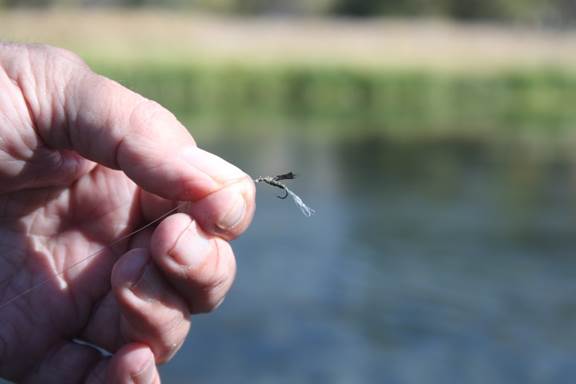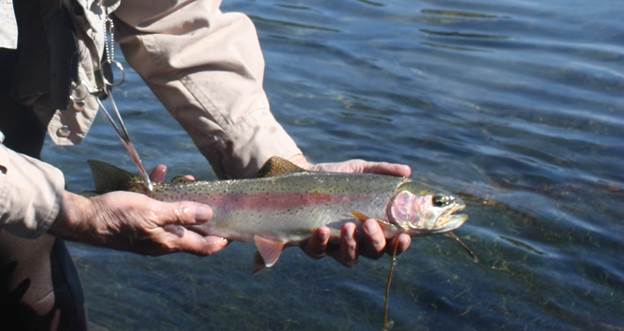MINIMALISM
The Dictionary provides the following definition for minimalism; something achieved by using a few very simple elements to maximum effect. It seems to me that the recent rise of Tenkara fishing is a response to the increasing complexity of Western fly fishing techniques. I'm not quite ready to sell my conventional fly fishing equipment and fully embrace the Tenkara fly fishing method; but I can understand the desire to simplify.
I have been moving toward minimization in my personal fly fishing paraphernalia for the last few years. For many years I wore a vest that allowed me to carry the inventory of a small fly shop around on my back. Along with all the gadgets, tippet spools, leaders, floatant, rain jacket, landing net, assorted split shot, etc., etc., etc., I had become a beast of burden. One year, when I was cleaning out my vest at the end of the season, I realized that many of the things I carried in my vest I rarely used. That was the beginning of my path toward minimalism.
Gradually I began to pare down the things that I carried in my vest. I sorted out my flies so that I had a collection of boxes that contained flies that I mostly use on stillwaters which I do not need to carry in my vest. I stored them in a white plastic bucket that I can pick up whenever I'm going to be fishing a stillwater. I organized all my other flies in a similar fashion.
Once I had uncluttered my vest in the fly box department I took a look at all the other stuff that I would normally be carrying about each time I went fishing. Did I really need several new leaders or could I get by with only a couple? Did I need to carry tippet spools from Ox down to 7x? If I was fishing within walking distance of my vehicle or floating did I need to stuff a rain jacket in my vest? Do I need a complete assortment of split shot since I rarely use anything larger than a couple micro shots? Suddenly my vest was much lighter.
During the recent fishing season I found myself fishing without a vest on several occasions. I have pared my must have items down to a few items that I can carry in a waist pack or even in the pockets of a fishing shirt. I carry floatant, a spool of tippet material, a small piece of Amadou, and a couple boxes of flies. I have a pair of nippers and a set of hemostats which are the only tools that I carry. I tuck my landing net under my wader belt in the middle of my back.
My next step in the quest for minimalism is the number and types of flies that I tie and carry. Actually, I have been working on this aspect of fly fishing for several years. Since I spend most of my fly fishing time fishing specific types of water it's possible to pare down the patterns that I need to carry. While I continue to experiment with new and different patterns I have a limited compliment of flies that have earned a place in the boxes that I carry on the water. If I find a pattern that performs better than one of my old favorites I remove the old pattern and replace it with the new one. This cuts down the number of flies that I carry and requires me to spend less time trying to select a fly to use and more time concentrating on presentation.
I have carried my quest for minimalism into my fly tying. Since I started fly tying nearly 50 years ago I have believed that the most productive flies are the least complicated. I believe that this is especially important when tying patterns for specific hatches and not simply tying attractor patterns. When I look at natural flies and compare them to many of the patterns that we use to imitate them I find that they are overdressed. Most of the natural insects are much slimmer and less bulky overall than many of the patterns that I see. I am continually cutting down on the amount of material that I use to tie many of the patterns that I use. I try to determine the key features that are essential in each pattern to make them effective and eliminate everything else. This provides a basis for continual refinement and puts an emphasis on observation and deductive reasoning.

A minimalistic fly pattern – a hook, tail, body and wing

A fine spring creek rainbow that thought my minimalistic fly was food
Now it's important to remember that this is not the only way to approach fly fishing. I find that limiting the number of patterns that I carry requires me to concentrate on fishing and not on changing patterns; however this might be not be everyone's cup of tea. Likewise, minimalistic fly patterns are not for everyone. Some people enjoy tying complicated patterns; they enjoy tying pretty flies where every turn of hackle is in place and all the tail fibers are exactly the same length. I know how to tie flies like that but I have determined for my personal use that the fish don't really care if there are three turns of hackle and not two and a half, or if all the tail fibers are exactly the same length. When the fish get that picky I will finally take up golf!
I think that minimalism is worth pursuing but it may not be for you, and that's OK. Once you have mastered the basics of fly fishing you need to find a personal challenge. Some anglers pursue big fish with light tackle, some anglers travel to exotic places to catch unusual fish, then there's salt water fishing, Atlantic salmon and steelhead, just to name a few of the various ways that anglers challenge themselves. Some anglers just want to catch fish and they wish to keep the challenges to a minimum, and that's OK too.
Whatever your take on minimalism I think that most of us can benefit from taking an inventory of all the stuff that we carry. Now, with winter still holding forth in many parts of the country, is a good time to take that inventory and perhaps lift some of the burden off your shoulders in the coming season.
